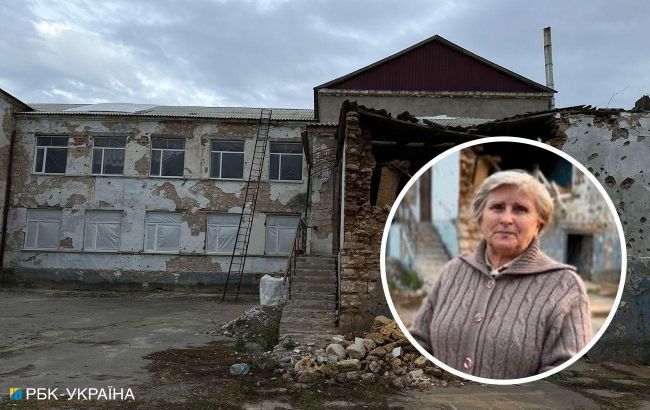War horrors: Kherson region after occupation and Kakhovka HPP explosion
 School in the village of Kalynivske (RBC-Ukraine collage)
School in the village of Kalynivske (RBC-Ukraine collage)
The Kherson region continues to experience the devastating impact of war. Those who survived the occupation and the flooding caused by the Kakhovka HPP explosion are now enduring escalated shelling by Russian forces.
Discover the daily realities of citizens in the front-line territories of the Kherson region and understand the crucial assistance they urgently require.
In recent weeks, the situation in the Kherson region has significantly intensified, with the Russians employing various weaponry, including artillery, rockets, and anti-aircraft missiles (guided aerial bombs). Reports are indicating indiscriminate shooting by Russian forces.
"The shelling has escalated considerably. We are being overwhelmed, literally brought to the ground. It feels like the Russians are seeking revenge because we didn't welcome them. Despite these relentless attacks, we refuse to surrender. In Bilozerka that night, the area was bombarded with hail and struck with phosphorus. But even so, we remain citizens," shares Inna, a Bilozerka village citizen.
She expresses gratitude on behalf of the community to everyone who comes to offer assistance.
"We are welcoming people, always trying to greet others with a smile. But underneath, if you strip it away, there's a desire to cry. Nevertheless, we will endure," she says.
 Photo: Consequences of shelling in the Kherson region (RBC-Ukraine)
Photo: Consequences of shelling in the Kherson region (RBC-Ukraine)
Traces of war are evident along the road to populated areas — shell casings, bullet marks, and shrapnel scars on house walls alongside demolished and mutilated buildings.
Anatolii Dzyubenko, a volunteer and head of the charity fund "I Help," who recently visited the Kherson region, reflects on life's challenges near the contact line. "Life is challenging. Shelling could commence at any moment, and the uncertainty of where the next enemy shell might land is ever-present. Employment opportunities are scarce in such regions, with farmers striving to resume their activities, a difficult process."
 Photo: Anatolii Dzyubenko, head of the "I Help" Foundation (provided to RBC-Ukraine)
Photo: Anatolii Dzyubenko, head of the "I Help" Foundation (provided to RBC-Ukraine)
He explains that certain individuals have not departed the Kherson region since the onset of the full-scale war. In contrast, others left temporarily but returned due to challenges in finding employment and financial constraints. Returning home provides the advantage of not having to bear the additional expense of renting a place to live.
 Photo: Traces of war in the Kherson region (RBC-Ukraine)
Photo: Traces of war in the Kherson region (RBC-Ukraine)
Surviving the occupation and liberation
Larysa, a citizen of Kalynivske village, guides us through the remains of the dilapidated school building where she served as a teacher before the war—a place deeply connected to her childhood.
"Following my education, I returned here, dedicating 42 years to working with children. Before the full-scale war, I served as a teacher transporting children. I vividly recall the morning of February 24 when, at 6 o'clock, I was heading to work. Our director called and said, "Hold back, there won't be transportation; the war has begun." It was incredibly frightening, especially upon learning about the bombings in Kyiv and the approaching Russians in Kherson. We hoped they would spare us," tells Larysa.
On March 9, the occupiers entered the village, swiftly settling into the homes of locals who had evacuated. Fortunately, many people managed to leave, primarily the younger generation and children.
"At the time, we had our granddaughter living with us, and we arranged for her to be with her parents in western Ukraine. I stayed behind because my mother, aged 84, is bedridden, and we lacked personal transportation to relocate her," explains Larysa.
She vividly recalls the day the village was liberated.
"Our scouts, our guys, were the first to arrive around noon. They hoisted the Ukrainian flag on the cultural center and the school. Four hours later, another team arrived. After all we had endured, it was hard to believe it was real. The entire village gathered, cried, celebrated, and embraced our boys," she shares her memories.
 Photo: Buildings mutilated by shelling in the Kherson region (RBC-Ukraine)
Photo: Buildings mutilated by shelling in the Kherson region (RBC-Ukraine)
The water reached the roofs
Larysa, a citizen of Kalynivske, first learned about the Kakhovka HPP dam explosion while traveling with her children to Mykolaiv.
Initially thinking the water wouldn't reach their area, the reality unfolded on June 7-8. The water infiltrated many streets and houses, particularly those near the river. In some homes, the water reached even under the roof, causing plaster to fall off, leaving bare bricks exposed, recounts Larysa.
The state program "Side by Side" provided substantial assistance, with the Vinnytsia, Cherkasy, and Dnipropetrovsk regions contributing to housing restoration. Larysa expresses deep gratitude to the non-governmental organization "Proliska," which promptly provided building materials when the water receded. International aid also played a crucial role.
"Many people came to our aid. Importantly, they brought water, as the water in boreholes and wells is unfit for drinking. Even now, they deliver drinking water — 20 tons each time," shares the Kalynivske citizen.
Heading into winter, the settlement urgently requires assistance, particularly in the form of firewood and coal. Previously, people could purchase firewood from the working forest farm, but now, with mining activities in full swing, locals are apprehensive about venturing into the area.
 Photo: Inna from the Bilozerka village helped with the evacuation of fellow villagers during flooding (RBC-Ukraine)
Photo: Inna from the Bilozerka village helped with the evacuation of fellow villagers during flooding (RBC-Ukraine)
In the Bilozerka, the scars of war are evident everywhere. Citizen Inna shows the street that was submerged just a few months ago.
"They are trying to raze us to the ground."
In the Kherson region, 20,000-30,000 homes found themselves within the flood zone following the Kakhovka HPP explosion. The terrorist attack on the dam resulted in the damage or destruction of thousands of homes belonging to Kherson citizens. Presently, these locals are grappling with heightened levels of shelling, further exacerbating their challenges.
"I remember turning on the news one morning and learning that the dam had been blown up overnight. Soon, the water gradually began to rise. We were on duty in the village, monitoring the situation. When the water approached dangerously, we started assisting in evacuating those who couldn't do it on their own. The police were involved, and we provided support," recalls Inna.
The flooding occurred overnight, inundating yards and houses. People evacuated with only the essentials—bags and documents. On the streets, the water reached under the roofs, causing three houses to collapse.
"The evacuation was well-organized — buses, the police, and assistance for people with reduced mobility, transporting them to safer locations for a temporary stay. We actively participated in helping everyone," says Inna.
Logistical challenges arise due to the proximity to the front line.
Recently, volunteers from the "I Help" foundation visited four communities in the Kherson region: Bilozerka, Kalynivske, Tiagynska, and Kherson.
"Our foundation has been operating in the front-line zone for a long time. We assisted people affected by the Russians blowing up the Kakhovka HPP. They've been through a lot — Russian offensives, occupation, and even after the liberation of territories, they faced danger. The terrorist attack on the dam damaged or destroyed their homes, and now they're experiencing increased shelling," explains Anatoliy Dzyubenko, the head of the foundation.
 Photo: Team of volunteers of the "I Help" Foundation (provided to RBC-Ukraine)
Photo: Team of volunteers of the "I Help" Foundation (provided to RBC-Ukraine)
Dzyubenko notes that the enemy can launch anti-aircraft missiles at one settlement three times a day in addition to artillery fire. Those living on the contact line are constantly subjected to massive shelling, as the rest of the Kherson region remains under occupation.
"People here need help the most because they experience all the difficulties of war 24/7. They witness the aftermath of every airstrike and shelling—destroyed houses, injured people, casualties, and a lack of security," he emphasizes.
Even though these territories have been liberated, people still require assistance.
"Finding employment is challenging here, and logistics are not always reliable. Many people are hesitant to come here due to the proximity to the front line. That's why we help these individuals," explains Dzyubenko.
 Photo: Handing out aid in Kalynivske from the "I Help" fund (provided to RBC-Ukraine)
Photo: Handing out aid in Kalynivske from the "I Help" fund (provided to RBC-Ukraine)
Often, significant contributions to such initiatives come from big businesses. In this instance, the fund received aid collected from its partners, including "Your Support" foundation and a famous supermarket chain. The donation comprised long-term storage products, hygiene items, and household chemicals for 470 families.

